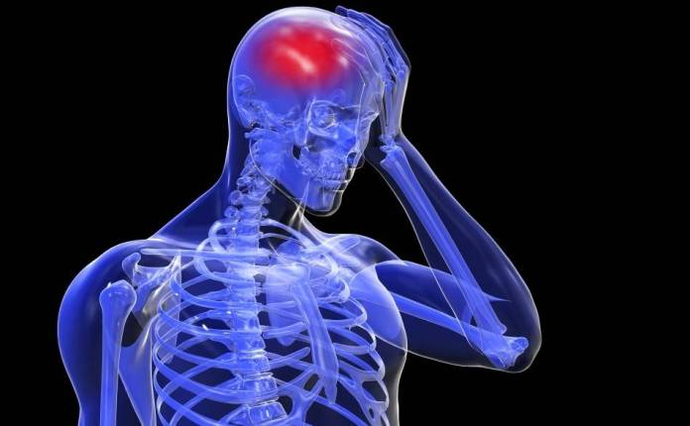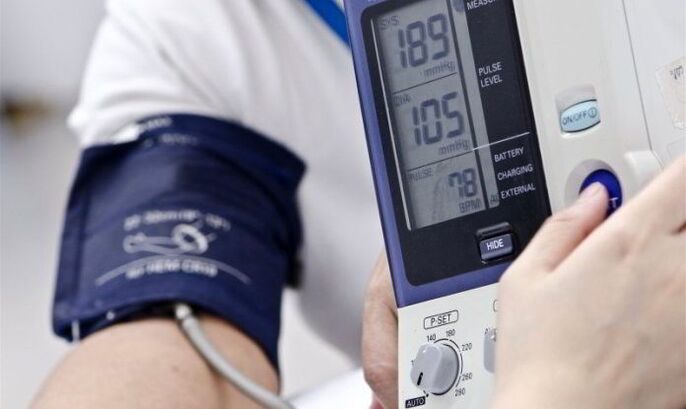Cervical osteochondrosis is a spine disease characterized by intervertebral disc disorders.The pathology is characteristic of the elderly, but a person of any age can meet him.Tangible discomfort causes one of the main signs of this disease - severe pain.The patient should know how dangerous cervical osteochondrosis is and what problems it will have.
The specifics of the disease
The cervical region is one of the most mobile parts of the body and it results in a regular load.With the development of osteochondrosis, the spine changes, which causes contraction of many vessels and nerves.The main difficulty of the pathology is that its characteristic dystrophic changes affect the roots of the spinal nerve and the intervertebral space discs.Because of this, the brain remains necessary without oxygen, the blood supply is lost.

In the risk zone, first of all, there are older people in which the disease develops in the wake of metabolic disorders, and changes in the structure of vertebrates and intervertebral discs are associated with age.The cause of such disorders may also be:
- Salt deposition;
- Inadequate physical activity;
- Improper nutrition;
- Injuries;
- Frequent hypothermia;
- Hormone problems;
- Excess weight;
- Chronic diseases.
Osteochondrosis also provokes the long -term presence of the body in one condition, which puts office staff and drivers under the blow.
Symptoms of osteochondrosis
In the early stages of the disease, the symptoms are almost invisible, anxiety can only cause mild neck pain.But as the pathology develops, the symptoms gradually increase.
Osteochondrosis of the cervical spine can be manifested by the following signs:
- Severe pain in the neck, beard, shoulders;
- Regular migraine;
- Hand weakness;
- Neck mobility is limited;
- When turning itself, the vertebrates are shredded;
- Hearing problems;
- The characteristic call appears in the ears;
- Discomfort in the throat.
In the early stages, pain syndrome only occurs during movement when angled or neck overhead.Over time, the pain occurs even when the position of the hands changes.
Possible complications
If cervical osteochondrosis is not treated, degenerative processes on the intervertebral discs will lead to loss of their basic functions and reduce density.Excessive mobility of the spine gradually develops, muscles, joints and ligaments are affected.Nerve endings and spinal cord pressure will only be activated, which will lead to the increase in symptoms and the development of new pathological phenomena.

Frequent migraine
Due to the most common consequences of cervical spine osteochondrosis, you can calculate headaches.This is due to the fact that this site is located on the spine artery, which is responsible for the supply of oxygen and blood to the brain.
As the strength of the disk changes, depreciation functions are violated.Deformed spine presses on the artery, interferes with blood circulation, and "supply" the necessary oxygen.Muscle cramps develop.
After pain, the accompanying symptoms often follow:
- Nausea;
- Vomiting;
- A sharp increase in pressure;
- Shoulder blades;
- Weakness throughout the body.
With severe attacks, it is advisable to rest as much as possible, better in a horizontal position.Unpleasant syndrome can remove painkillers or cold compresses while the massage is useless.
Vision problems
Complications of cervical osteochondrosis often affect the organs of the vision: in this part of the spine there are sleep and spine arteries responsible for the visual central structure of blood flow.Compression of nerve roots and blood vessels causes hypoxia and causes a decrease in vision.
With spine artery syndrome, symptoms such as:
- Fog;
- Involve in the eyes;
- Appearance of "owls" or colored spots;
- Bifurcation;
- Excessive stress on the optical nerve;
- Dizziness;
- Nausea.

During the examination, the specialist may notice the narrowing of the retinal vessels of the retina, less often swelling of the optic nerves.Also, in the wake of the disease, glaucoma may appear, accompanied by intraocular pressure and pain.
Hearing Problems
Due to contraction of the spine artery and nerve roots, hearing loss can be reduced by 20-30%.Osteochondrosis of the cervix can cause deafness.To avoid this, you should contact your doctor about the first symptoms of the disease.
A slight reduction in hearing is reversible: In addition to the treatment prescribed by your doctor, the patient needs special exercises or mass of ear vessels.Watching TV or listening to music is better for a small volume to strain the hearing organs.
Hypotension or hypertension
Reducing blood pressure or increased cervical osteochondrosis is a very common result.The biggest danger is hypertension that is characteristic of:
- Pulse Ocomuation;
- Increased sensitivity to temperature;
- Sleep disorders;
- Nasal bleeding;
- Dyspnoea;
- Heart pain;
- Sweating.
The higher the blood pressure, the greater the load on the heart, which causes its faster wear.As a result, heart failure develops.During hypertension, atherosclerosis develops faster, which is dangerous during brain stroke.
Hypotenia is not a direct threat to life, but it greatly affects its quality.The body suffers from oxygen starvation, which affects the patient's general well.Hypotonia is characterized by impaired venous and arterial blood supply and this implies the sensitivity of the limbs.Among the possible complications is myocardial infarction.

Veges -Vasicular Dystonia
Veges -Vazricular dystonia is a general indication of the syndrome that can affect several body systems and organs.Most of the pathology, cardiovascular system and peripheral nerves experience pathology.The patient suffers from constant anxiety and sharp emotional differences.Frequent panic attacks are also possible, and heart rhythm becomes more common.
Symptoms of dystonia can be lubricated or disguised as other diseases.The effects of osteochondrosis in the cervical region in this case are also not the most pleasant.So the gastrointestinal tract often suffers: nausea and vomiting, diarrhea, constipation and severe abdominal pain are possible.Gallbladder or liver disorders may occur.Patients often complain of tachycardia, pressure problems and heart pain.
Intervertebral hernia
Intervertebral hernia, disk fragments are "impregnated" in the spinal canal or collapses.The initial stage of this pathology is called protrusion.The integrity of the intervertebral disk does not remove it, but there is a slight protrusion of bones in the spinal canal.At this point, pressure on the roots of the spinal cord, so the main symptom is a weak pain that occurs during movement.At a later stage, pain syndrome is improved.
Spine mobility gradually decreases.Muscle tension is improved, even if the patient seems to be in a relaxed state.You can also mention periodic weakness in the upper part of the hands or wrists.Hand bumps appear and a quarrel is often found near the thumb.
This is what a hazardous osteochondrosis of the cervical spine is a hernia: it has a serious load on the artery that passes along the spine column and is essential for proper blood supply to the brain.If the patient's excessive pressure occurs, ischemic stroke may be expected.
Large hernia is dangerous for inflammation of the surrounding ligaments - it is full of cervical sciatica.Only timely treatment can prevent complications.The patient needs to be careful to listen to his body and consult your doctor for the first symptoms.Doubts should cause:
- Sharp attacks of nausea for no striking causes;
- Movement during movement;
- Noise in the ears when turning around;
- Neck sensations with a long stay in a constant state.
The most serious complications are the risk of irreversible paralysis of one or both hands.Atrophy of the cerebral nerve causes this, located in the cervical region.If the hernia begins to pressure the bloodstream, they will gradually die, which will cause many organs to innervate.
Vestibular-Bareli syndrome
Vestibular-Bareli syndrome is a condition in which the patient suffers from severe dizziness, which is accompanied by loss of orientation.
Attacks arise with a sharp rise, quickly turning or heading back.Characteristic of the state:
- Noise in the ears;
- Nausea;
- Visual impairment;
- Feeling that everything is spinning in front of the eyes and swimming.
The main cause of the pathology is the absence of blood supply, which implies dysfunction of the vestibular apparatus.The syndrome will occur more and more often as osteochondrosis develops.
A majestic minute syndrome
Running osteochondrosis is dangerous with neuro-vascular disorders of the throat and larynx.Syndrome is characterized by:
- Roughness;
- Difficulties in swallowing;
- Constant feeling of coma;
- Dryness and pain;
- Complete loss of sound.
The syndrome suddenly occurs and is accompanied by dizziness.
Syndrome Bar Lieu
The second name of the pathology is spine artery syndrome.The cause of its development is the stenosis of the spine (narrowing), in which the spasms of the spine and the blood vessels and nerves contract.
Symptoms include:
- Hypertension;
- Nausea;
- Tachycardia;
- Carved in the eyes;
- Noise in the ears;
- Loss of coordination of movements;
- Pulse pain in temples or in the back of the back.
With sharp motion or turning the neck, the patient may lose consciousness.

Hypotolamic syndrome
At the same time, the hypothalamus suffers from syndrome - a part of the brain responsible for human metabolism, pressure, sleep, body temperature and emotional reactions.Functional disorders can be manifested by enhancing or weakening the action of the brain section.In the first case, the patient becomes irritable, in the second - inhibited.
Symptoms often resemble neurasthenia, which is itself:
- Sleep disorders;
- Dissatisfaction;
- Irritation;
- High fatigue;
- Mood infertile.
A person loses the ability to concentrate, there are problems to remember.Unreasonable spread of madness is possible, appetite disappears, libido decreases.
It is best to avoid any disease than treatment, it is quite difficult to predict osteochondrosis behavior.If there are risk factors, you should regularly perform a set of simple physical exercises that will increase the mobility of the spine and eliminate swelling in the collar.
Frequent appearance of any of the symptoms described in the body's obvious signal to the problems in it.At the same time, self -government is useless and without consulting a specialist it will not work.

















































